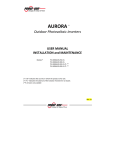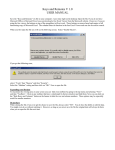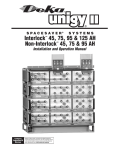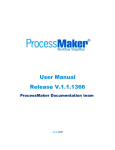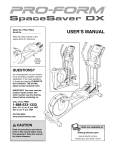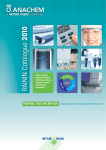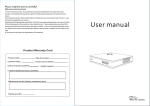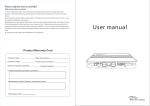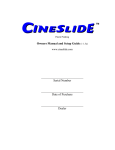Download Chapter Five
Transcript
Chapter Five Troubleshooting & Bench Bleeding 5.1Master Cylinder, Caliper & Power Brake Booster • • • • • • • • • • • • • • • • • • • • • • • • • • Excessive play in pedal • • • • • Hard pedal Spongy pedal Pedal sinks to floor Pedal vibrates • Brakes grab • • Brakes drag • • Brakes pull • Erratic braking Squeal or chatter • • • • • • SYMPTOMS PROBABLE CAUSES Low fluid level Air in hydraulic system Brakes need adjustment Brake fade due to overheating Grease or fluid on brake linings Brake linings glazed Brakes wet Faulty vacuum booster • Brake linkage binding Weak flexible hoses Loose or worn wheel bearings Loose or worn front end parts Front wheels out of alignment • • • • • • Loose disc brake caliper Warped brake disc • • • • • • • Eccentric brake drum Faulty wheel cylinder Faulty master cylinder Weak or broken retracting springs Scored brake drums • • 26 Dirt in brake mechanism Clogged or kinked brake lines Disc brake caliper piston frozen 5.2 Bench Bleeding Instructions or installer does not have access to the proper tools and service manuals, or does not have the proper training or experience, the services of a qualified technician should be used. You MUST bench bleed the master cylinder before installing it OR WARRANTY WILL BE VOID. Guidelines & Installation Tips WHERE TO BEGIN It is very difficult to bleed all of the air out of the master cylinder after it is installed on the vehicle. It is necessary to bleed the unit before it is installed. It is critical that you keep the work area clean when working with hydraulic brake components. Dirt or other contaminants cannot be allowed to enter any of the brake components. Before installing the replacement unit, you must take the following steps. Failure to observe these precautions can lead to misdiagnosis and possibly damage the replacement ABS unit. Follow these steps: 1. Clamp the mounting flange of the replacement master cylinder in a bench vise. Do not clamp on the body of the master cylinder as this could damage and void the warranty. 1. Find out what caused the original ABS unit to fail. 2. Install bleeder tubes supplied with the master cylinder into the outlet ports. 2. Fix whatever caused the failure. 3. Fill master cylinder reservoir with clean brake fluid and hold the ends of the bleeder tubes under the fluid level. 3. When handling ABS control modules, use extreme care to avoid damage from static electricity. 4. Use a wooden dowel or similar device to slowly push the master cylinder piston in about one inch, then slowly release the piston. 4. Do not remove the ABS unit from its shipping carton until you are ready to install the unit. 5. Do not allow dirt or fluids to contaminate the ABS electrical harness connections. 5. Wait 15 seconds and repeat step four (including the waiting period) until you no longer see any air bubbles in the reservoir. 6. Do not remove sealing labels or protectors until unit is installed on vehicle. 6. Install the replacement master cylinder on the vehicle. 7. The entire brake system must be flushed using only DOT 3 or recommended fluid according to OE instructions before operation of the replacement ABS unit. 5.3 ABS Diagnosis & Repair REMOVING THE ORIGINAL UNIT This section is divided into two parts. The first provides general guidelines and helpful tips for the removal, installation, and testing of ABS components. The second part gives more specific information for some of the major ABS systems. All information is provided as a guide only and is not intended to replace manufacturers service manuals and procedures. If the service technician 1. Before disconnecting power to the ABS system, record any stored codes using the appropriate scan tool and OE recommended procedure. 27 2. Before disconnecting any hydraulic lines, deplete system pressure by depressing brake pedal 40 or more times with ignition off until a firm pedal is obtained. 2. If pedal action does not feel normal, repeat the entire bleeding and test procedure. 3. Road test the vehicle after verifying that all systems function properly and that there are no error codes. 3. Disconnect the battery ground terminal to avoid risk of short circuit and electrical damage. While it is not difficult to service ABS components, you must remove, install and test the replacement unit as described by service manuals specific to your vehicles. 4. Clean the area around the ABS unit hydraulic lines to prevent contamination of the brake system when lines are removed and to protect the replacement unit. ABS CHECKLIST 5. Remove original unit following recommended OE service procedures. Tips for trouble-free installation. Do the following when installing the replacement unit. 6. Thoroughly flush the entire brake system before installing replacement unit. DID YOU: l Retrieve and record any stored codes before disconnecting electrical power? INSTALLING THE REPLACEMENT UNIT l Determine and correct what caused the original ABS unit to fail? 1. Remove the replacement ABS unit from its carton and place the original unit in that carton to assure proper core credit upon return. l Depressurize brake system by depressing brake pedal 40 or more times with key off? 2. Use grounding wrist strap to protect unit from static electricity damage. l Clean area around ABS hydraulic fittings and electrical connectors? 3. Follow OE recommended installation procedures and any enclosed instructions. l Flush entire brake system using approved brake fluid before installing replacement unit? 4. Flush and bleed the ABS system using OE recommended brake fluid from a fresh sealed container. l Follow OE service procedures and all enclosed guidelines for ABS unit removal and installation? NOTE: Under normal driving conditions the ABS system should be flushed every 2 years or whenever any brake system component is replaced, whichever occurs first. Always use OE approved fluid from a fresh sealed container. l Follow OE testing procedures before operating vehicle? l Road test vehicle to verify all systems are functioning correctly? TESTING THE ABS SYSTEM Failure to perform these checks and procedures will lead to incorrect installation and premature system failure. 1. Using suitable test equipment, follow recommended OE testing procedures before operating the vehicle. 28 Road Testing NOTE: Do not turn the ignition on after depressurizing the system unless specifically instructed to do so in a service procedure. Pedal action must be firm and normal before moving the vehicle. Do not drive the vehicle if codes are stored or pedal action is not normal. Bleeding Front Wheels First put the vehicle through a series of moderate braking actions. If the system functions normally, then run a series of hard stops at low speed (attempt wheel lock). This procedure requires two persons unless a pressure or vacuum bleeder is available. DO NOT turn ignition on. If moderate braking produces pedal pulsation or if hard braking produces wheel pull, then stop the vehicle. With the ignition “off,” remove the brake fuse (check the owner’s manual for location). Repeat the road test. • Begin with the right front wheel caliper. • Attach a bleeder hose to the bleeder valve and submerge the opposite end in a clean container partially filled with brake fluid. • Slowly depress the brake pedal. If pulsation or pull persists, check for a mechanical problem in the brake system. Make any necessary repairs. • Open the bleeder valve. To assist in removing trapped air, tap LIGHTLY on the caliper with a rubber mallet. Reinstall the brake fuse. Repeat the road test. If the problem returns, refer to a suitable service manual for diagnostic troubleshooting. • Close bleeder valve. • Release brake pedal. • Check fluid level and add as necessary. • Repeat the procedure until the brake pedal feels firm and no air bubbles are present in the bleeder hose. DELCO MORAINE III Depressurizing the System Always depressurize the system before performing any service operations including a check of the brake fluid level. Use only new DOT 3 brake fluid from a sealed container. DO NOT use fluid from an open container that may be contaminated with water. DO NOT use DOT 5 brake fluid. • • Bleeding Rear Wheels To depressurize the system, turn OFF the ignition. FIRMLY apply and release brake pedal 40 or more complete strokes. A noticeable change in brake pedal feel (hard pedal) will occur when the accumulator is completely discharged. Be sure ignition is off during procedure. Clean and remove reservoir cover and fill to correct level. Replace cover securely. 30 • Turn the ignition to the RUN position without starting the engine. Allow the pump motor to run to pressurize the accumulator. The pump motor will shut off when fully charged. Turn the ignition OFF if the pump motor runs for more than 60 seconds. Refer to the vehicle service manual to troubleshoot the problem. • Begin with the right rear caliper. • Attach bleeder hose to bleeder valve and submerge the opposite end in a clean container partially filled with brake fluid. • Open the bleeder valve. • With the ignition ON, slowly depress the brake pedal part way, until brake fluid begins to flow from the bleeder hose. (DO NOT press the brake pedal fully during this step). The pump motor may engage during this step, which is normal. Allow the brake fluid to flow for 15 seconds. To assist in removing trapped air, tap LIGHTLY on the caliper with a rubber mallet. • Repeat this procedure one more time. • Perform the motor rehome sequence (see manufacturer’s ABS service manual for details on procedure). Manual Bleeding Use only new DOT 3 brake fluid from a sealed container. DO NOT use fluid from an open container that may be contaminated with water. DO NOT use DOT 5 brake fluid. • Close the bleeder valve and release the brake pedal. • Repeat this procedure until no air is visible in bleeder hose. • Clean and remove reservoir cover and fill to correct level. Replace cover securely. • Add brake fluid to the rear chamber of the reservoir to approximately 1 inch below the full mark. • Bleeding sequence: right rear, left rear, right front, left front. • Repeat the process on the left rear caliper. • Attach a bleeder hose to the bleeder valve and submerge the opposite end in a clean container partially filled with brake fluid. • Test drive the vehicle. • Open bleeder valve. • Slowly depress brake pedal. • Close bleeder valve and slowly release brake pedal. • Wait 5 seconds. • Repeat the process at each wheel in the appropriate sequence including the five second wait, until the brake pedal feels firm and no air bubbles are present in the bleeder hose. Check brake fluid level periodically during bleeding sequence. • Test drive the vehicle only after pedal action is firm and normal. DELCO MORAINE ABS VI System Preparation Before bleeding the brakes, the front and rear displacement cylinder pistons must be returned to the topmost position (motor rehome). The motor rehome function cannot be performed if any current Diagnostic Trouble Code (DTC) is present. If DTC’s are present, the system must first be repaired and the DTC cleared before proceeding with motor rehome procedure. Refer to the manufacturer’s ABS service manual for further information. Obtain and Clear Codes • Start the engine and allow it to run for at least 10 seconds with brake pedal NOT applied. This will allow the ABS system to initialize itself. • Make sure the ABS indicator lamp is OFF after about 3 seconds. If not, refer to service manual. 31 ABS PRECAUTIONS AND SERVICE TIPS • Change brake fluid every two years or when ABS service is required. • Use approved brake fluid from a sealed (new) container. DO NOT use silicone brake fluids in ABS equipped vehicles. Refer to master cylinder lid or service manual for specific fluid type. • Never overfill fluid reservoir. Always refer to service manual or owner’s manual for specific filling instructions. • Never open a bleeder valve or loosen a hydraulic line while ABS is pressurized. The accumulator must be depressurized according to individual manufacturer’s repair instructions. • Never push caliper/wheel cylinder pistons back in their housing without opening the bleeder valve first. Unless bleeder is opened contaminated fluid will be forced back through system and may cause ABS components to fail. • Never disconnect/reconnect any electrical connectors or components while ignition key is on. Disconnect ALL on-board computers while using electrical welding equipment. • When installing entertainment or transmitting devices on ABS equipped vehicles, do not tap into ABS wiring or locate antenna or wiring near ABS control unit or its wiring harness. 32 • Do not tap on speed sensors. Striking components can cause demagnetization or polarization, affecting the accuracy of signal return to ABS control unit. • Do not overtighten wheel lug nuts. Rotor/drum damage may occur which can lead to inaccurate wheel speed readings. • Do not mix tire size. Increasing tire width is acceptable as long as the height on all four wheels is identical. NOTE: using a spacesaver tire can set fault code or shut down ABS control. • Check sensor to ring air gap, if applicable, if removed or replaced. • Check speed sensor components for grease, dirt or metal filings. • Check ABS for codes set when turning wheels during wheel/brake service. Spirited driving habits such as wheel spin or wheels leaving ground contact can set ABS codes. • Make sure system is properly bled and inspect entire brake system before road testing vehicle.






